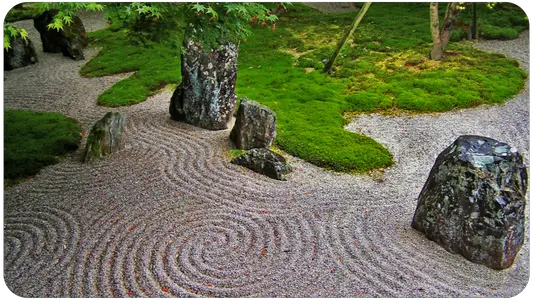Dharma (transcription from Sanskrit: धर्म) or dhamma (from Pali: धम्म) is a polymorphous and important term in Indian spiritualities and religions. Depending on the context, the definition differs and the word offers a wide range of meanings, theoretically all derived from the Sanskrit root dhṛ, "to bear, to support":
natural or legal law, norm, custom, duty ;
substance, essence, characteristic, truth, reality;
good, virtue, righteousness, justice, merit;
teaching, doctrine, religion;
phenomenon, thing, fact of consciousness.
In a general way, then, dharma refers to all norms and laws, social, political, familial, personal, natural or cosmic.
The term is translated as 法 in Chinese (fǎ) and Japanese (hō), in the sense of "law," and can refer to a "teaching," religious or not, especially that of the Buddha.
It is also sometimes translated, in the West, as "religion", although the original Indian beliefs, namely Hinduism, Buddhism, Jainism and Sikhism, do not attribute to it a meaning equivalent to the Western concept.
Finally, in Hindu mythology, it is a sage (rishi) personifying justice and natural order.
Translations
In the Chinese and Chinese-influenced world, the ideogram for dharma is 法, pronounced fǎ in Mandarin and hō in Japanese. In Tibetan, it is said tcheu, spelled chos: ཆོས.
Hinduism
In Hinduism, the word has the following meanings: Cosmic universal order; eternal law; morality, duty; virtue; righteousness. Hinduism refers to itself as Sanātana-Dharma (सनातन धर्म), "eternal law."
Brahman (the Absolute) is represented as having a higher force above it: 'dharma [which] is the sovereignty of sovereignty. Therefore, there is nothing superior to dharma. "Dharma is also "the eternal Truth that rules over the world.
This term has a more general legal aspect (see also Hindu law). It refers to the laws governing the world, both at the macrocosmic and microcosmic levels. Breaking these laws leads to an imbalance that jeopardizes the cosmos, at both the macrocosmic and microcosmic levels.
Thus Indian society is governed by laws, defining the duties of each according to his caste, and breaking these laws, apart from an imbalance of the society, is supposed to lead to an imbalance and destruction of the whole universe.
Krishna says in the Bhagavata Purana:
"non-violence, truthfulness, absence of any desire to steal, non-submission to desire, anger and covetousness, activity directed towards that which is good and pleasing to all beings, this is the common dharma of all castes."
In addition to caste-based duty, dharma also sets out the specific duties of each of the four ages of life.
These laws are the subject of treatises or dharmaśāstra, among which the most famous is undoubtedly the Laws of Manu or Manusmriti.
According to the Indianist Jan Gonda: "The doctrine of dharma and purity is most closely connected with the principle of reincarnation, a principle which the Hindu cannot question, with the idea that it is indispensable for all those who have not attained deliverance to return unceasingly to an existence determined by karman. "
Personification
Dharma "the Just", may be a sage (rishi) personifying justice and natural order; he is said to have come from the right nipple of Brahmā.
He is also equated with Yama, charged with judging men according to their actions.
He married thirteen daughters of Dakṣa: Śraddhā whose sons he had Nara and Kāma; Maitrī; Dayā; Śānti; Puṣṭi; Tuṣṭi whose sons he had Saṃtoṣa; Kriyā whose sons he had Daṇḍa, Naya, and Vinaya; Unnati; Buddhi; Medhā; Titikṣā; Hrī; Mūrti.
The "wife" (or shakti) of Dharma is Ahimsâ ("Non-violence"); thus, both Dharma and Ahimsâ are divine parents of Lord Vishnu :
for it is Ahimsâ that allows Dharma to exist and be incarnated on Earth (without the promotion of Non-violence among creatures, the Cosmic Order is in danger; without Ahimsâ, there is no Dharma - and vice versa), and it is for the protection of Ahimsâ that Vishnu becomes an avatâr ("Descent" of God on Earth) to impose Dharma, fight demons and render harmless those who ignore or despise it, favoring the end of the "Three Worlds ".
He sometimes takes on human or animal forms to put men to the test9.
Buddhism
In general
In its current meaning, the Dharma (with a capital letter) is the teaching of Shakyamuni Buddha and one of the three jewels (or "three treasures") of Buddhism.
The Dharma is also the Buddhist or natural law , and the teaching is an observation of the functioning of the world and the mind, which Buddhism strives to transmit and explain.
The term has a number of meanings that should be taken into account when reading Buddhist texts. Non-Western texts refer to Buddhism as Buddhadharma (ch. Fófǎ 佛法).
In this context, Dharma no longer refers so much to precepts (laws governing the Hindu way of life and religious prescriptions), but to the historical Buddha's own teaching, which describes, for example, the source of dukkha ("suffering," "dissatisfaction," "unhappiness"), its cessation, and the path that leads to that cessation.
Very often one teaching leads to the other. For example, meditation on the teachings on the impermanence of phenomena and their interdependence, soon followed by intimate experience of this reality, prepares one for the teachings on essential emptiness (non-substantiality), and elicits its immediate intuitive apprehension from the highest perspective (Paramārtha).
In Buddhist treatises, the Dharma is one of the three refuges-also called the three jewels or "three treasures":
"The gift of the Dhamma surpasses all gifts; the flavor of the Dhamma surpasses all flavors; the delight in the Dhamma surpasses all delights. "
To take the three refuges means, in Buddhism, to rely on the strengths of the Buddha, the Dharma (the body of teachings), and the Sangha (the body of practitioners), in order to secure one's liberation from the torments of the saṃsāra.
This is the first commitment to be made to a competent Dharma Master in order to become a true Buddhist worthy of the title of disciple of Shākyamuni Buddha.
The Buddhist Dharma is symbolized by a wheel (dharmachakra) and the Buddha's first sermon is often equated with the first setting in motion of the wheel of the Law (Dhammacakkappavattana Sutta), the first turn of the wheel of the Buddhist Law.
In the plural, dharma can also be translated and understood as things, material objects, or mental and physical phenomena. To make the distinction, by convention, the Buddha's teaching is given an initial capital letter.
In Zen Buddhism, the transmission of the Dharma teaching from master to disciple, called shihô, is attested by a document called shisho.
In Nichiren's teaching, the Buddhist Law (法, Hō) refers to the teachings of the Buddha defined by the sutra (経, Kyō), and specifically to the Wonderful Law (妙法, Myōhō) of Nam-myoho-renge-kyo (南無妙法蓮華経), the title of the Sūtra of the Lotus transmitted for the time of the End of Shakyamuni's Law or End of the Dharma:
"Japanese Buddhists regarded the era of the End of the Law as a verdict of guilt against misguided humanity. Reinterpreted by Nichiren, the era of the End of the Law became the era of kosen-rufu - an era when the teachings of the Lotus Sutra would spread widely throughout the world. "
The particular case of the Pali word dhamma
The Palis commentaries give two definitions of the word dhamma, depending on the root from which it is derived.
Root DHṚ: to bear, to support
"Dhammas are said to bear their own mark ". Any characterizable element is dhamma. The commentaries cite ten of them:
the Tripitaka
a truth
a samâdhi
paññâ
a natural state
a proper nature
emptiness
merit
a transgression of the rule
a thing to be known
Root DHᾹ : to place, to establish
"A condition is said to be dhamma because it establishes this or that ". Here, the pair dhamma - attha represents the condition and the resulting effect. For example:
an expression and its meaning;
the path and the Nibbâna that follows it;
the beneficial or pernicious states and the resulting or functional states.
Jainism
Jainism, also called Jain Dharma (जैन धर्म), uses the word dharma in several meanings. Dharma means: religion and also: duty. However as the substance of the universe or dravya, dharma or arupi-ajiva belongs to the ajivas: non-sentient matters.
The jivas are their opposites: they are the souls: The ajiva (i.e., "non-jīva") includes matter in all its forms: pudgala, and also and the formless and meaningless "subjects": the kāla (time), the ākāśa (space), the dharma (the principle of movement), and the adharma (the principle of rest).
Sikhism
For Sikhism, dharma has two major meanings: religious teaching on the one hand, and, daily conduct on the other. In short, one must attain moksha, liberation from the cycle of rebirths, as quickly as possible by following altruistic and spiritual conduct. Sikhism professes to serve God and fellow human beings regardless of one's background, creed or gender.
Guru Nanak, the founding guru of Sikhism, wrote to teach his believers: "Those who wish to gain a seat in God's presence must devote themselves to the service of people in this world"; the guru is referring to sewa, the Selfless Service advocated by some Eastern religions. It is also written in the holy book of the Sikhs: "According to one's own actions, some come closer (to the divine), others further away.





